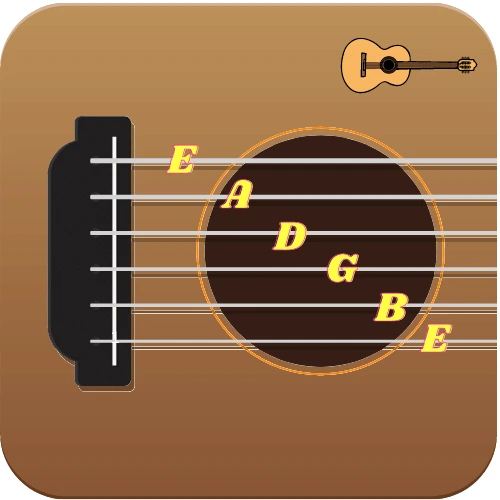- What exactly are the guitar strings?
- Anatomy of guitar strings
- How to remember the string’s names on a Guitar?
- Which strings are suitable for playing guitar?
- How to string your guitar?
- Why care about guitar strings?
- Why should we care about the guitar strings?
- Why is learning guitar strings appropriate?
- How to play with guitar string names?
- Tips for Guitar Beginners
- Recommended strings of the guitar for your instrument
- Key points for storing your guitar strings
- Conclusion:
- Frequently Asked Questions on Guitar String Names
With an experience of playing Guitar for 15+ years, the most important suggestion to any aspiring guitarist is to memorize Guitar string names.
Being one of the most popular instruments globally among all age groups, the guitar is in almost all the niches of the music ranging from rock, to pop, jazz, to blues. To start with the basics, it generally has six strings and the names from the thickest to the thinnest string are E, A, D, G, B, and E. The sixth string is the lower E string and the first string is the high E string. However, guitarists tune their guitars in different ways which is majorly dependent on the type of music they are keen to play, however, let us understand the concept of standard tuning here and dive into the concept of various guitar strings, and their names. We will also uncover some common questions around the same and share valuable tips.

What exactly are the guitar strings?
Guitar strings are metal straps usually thin in nature which stretch across the neck of the instrument and produce different notes. Guitarists use their fingers to pluck the strings, produce different sounds and play the Guitar. The type of strings used, impact the sound produced.
The two major types of guitar strings are nylon and steel. Classical guitars or flamenco guitars use Nylon strings and the steel strings are implemented on the acoustic and electric guitars and produce a different twangy sound. Electric guitars also use Steel strings.
Guitar stings come in a set of six. The lower E string is the thickest and the lowest pitched while the highest E string is the thinnest and highest pitching. There are also A, D, G, and B strings in between where all the thickest and thinnest strings produce different notes when plucked.
Different strings are usually fetched from different materials and the common of all stays steel. There are also bronze, brass, and nickel-plated steel strings and sometimes animal intestines are also used as strings. Different materials make different sounds for example gut strings have a varying warmer sound than the steel strings.
Anatomy of guitar strings
The guitar strings have three major parts: the core, the wrap, and the windings. In this core forms the central part and the strings are steel, nylon, or metal. These windings are thin wires around the core and these windings affect the vibration of the string.
The names of Guitar strings are in order with the notes. The six strings of a standard guitar are basically in tune with the notes E, A, D, G, B, and E. The lower string E is the thickest and the lowest pitching. The high E string is the thinnest and chest pitched string. There are the A, D, G, and B strings in between. These are all the different thicknesses while producing various notes whenever played.
Knowing the names of the strings can help you effectively tune the Guitar and find all the essential notes on the fretboard. Knowing the names of the strings makes it easier to learn chords and melodies making it extremely crucial to learn the names of the guitar strings.
How to remember the string’s names on a Guitar?
When you initiate it becomes difficult to understand and remember the string names in order but with time and practice it becomes easier to remember the string names. However sometimes to proceed by understanding or following little phrases or sentences is useful.
Eat A Dog, Get Big Ears
Elephants And Donkeys Grow Big Ears
Even Average Dogs Get Bones Easily
Eddie Ate Dynamite, Good Bye Eddie
Which strings are suitable for playing guitar?
The material used in each part of the string significantly impacts its sound. For instance, if the strings have a steel core and bronze wrap that has a brighter sound than those with a nylon wrap. It is important to note that different manufacturers make use of different materials to create strings and produce different sounds.
Strings are available in different gauges or thicknesses. This gauge of a string is a measure of in thousandths of an inch. A thicker string needs to have a higher gauge than a thinner string. Guitarists choose a string gauge which is based on the music type that they want to play. For example, lighter gauge strings are often used for rock because various gauges of strings help in producing the right sound as required.
Wondering what strings are right for you? This completely depends on the type of sound you are aiming at. If you are unsure, it is always recommended to seek a professional guitar coach for help.
How to string your guitar?
To string a guitar, you need to follow the steps given below:
- Remove your bridge pins by using a tool as shown.
- Place the new set of strings securely in the right sequence.
- Cut the excess length of the strings using a plier.
- Place the strings closely inside the hole and use a hand-winding tool to turn the strings tighter by using the tuning pegs.
- Once all the strings are properly in place, use a guitar tuner to tune the guitar.
Just in case, if you are stuck whilst ringing your guitar, take the help of resources online or from a professional guitar coach.
Why care about guitar strings?
Guitarists usually choose a string gauge based on the type of music they intend to play. Therefore, the choice of guitar strings is important for guitarists who aim to produce a specific sound.
Why should we care about the guitar strings?
Guitarists choose a string gauge based on their personal preference. Each Guitar strings plays a vital role in impacting the sound. Different materials create strings with different sounds.
Why is learning guitar strings appropriate?
Learning about the strings of the guitar is important as it helps understand the different sounds produced by a guitar. if we properly know or learn about the strings of the guitar we can:
- Choose the adept set of strings and get just the right tone from our guitar.
- Avoid any implementation of the wrong type of string for a particular song.
- Better understand our instrument and get the most out of it.
How to play with guitar string names?
We need to analyze and understand how to play with different string names. The guitar’s six strings are placed in either ascending or descending ways. The thinnest and highest-pitched string is the high E string followed by the B, G, D, low A string, and E strings respectively. Therefore, the order of the string from thinnest to the thickest is E, B, G, D, A E.
Tips for Guitar Beginners
Beginners are recommended to start by practicing some basic chords. You can start by trying a simple minor A or D chord. These two chords basically need only three strings and make an excellent piece for basic chords. A chord is a mix of two or more notes together.
If you are a beginner, it is important to get accustomed to the names of the strings. This helps in tuning the guitar and understanding the tablature or a tab. A tab is usually corresponding to the strings from thinnest to the thickest: E, B, G, D, A, E.
Recommended strings of the guitar for your instrument
When it comes to finding the best guitar strings, we should keep a few points in mind:
- Consider the type of music you wish to play. If it is rock music, you will need different strings than a classical guitarist.
- Think about the tone required to achieve. If you wish to bring a more serious sound or a darker sound, you would want different strings.
- Consider the action of the climate in which it will be played. If you are located in a humid climate, you need to get strings less likely to corrode.
Key points for storing your guitar strings
If you are not planning to play guitar for a while, it is important to store these strings properly:
- Wipe your strings with a clean cloth to avoid any corrosion of the strings.
- It is imperative to loosen the strings slightly to relieve any tension on the strings.
- Store your guitar in a cool and dry place.
- It is also recommended to avoid places where the strings are away from extreme temperatures.
Guitar strings are vital for your instrument and there are a few things to understand about the strings:
The most crucial thing regarding the guitar strings is the tension. This also implies that these strings can easily break if not handled properly. With the changing strings, a string winder is used. Also, ensure not to remove any string by simply pulling it with your hands as it can lead to breaking or injuring the cords.
Conclusion:
To learn about the guitar string names is important in understanding how to play the guitar. The key is to remember the names of the guitar strings in the form of a phrase. By understanding and learning the basic information, you can easily become an enthralled guitarist.
Frequently Asked Questions on Guitar String Names
The notes on 6 strings on a Guitar are named as EBGDAE from thinnest to the thickest.
Through a simple phrase like, Eat A Dog, Get Big Ears
The first string is E, the difference is that the lowest E string is the thickest and the highest string is the thinnest E.
The six strings on the Guitar are known as EADGBE in a standard way of tuning or DADGBE, DADGAD, BF#, etc.

































1 thought on “How to remember Guitar string names”